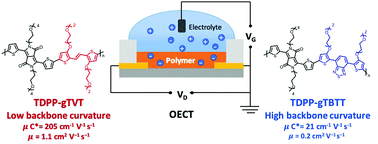
Organic mixed (ionic and electronic) charge conductors are the building blocks of state-of-the-art bioelectronic devices, including the organic electrochemical transistors (OECTs). Despite the interest in OECTs, the library of polymers that show efficient mixed charge transport is still narrow. In this work, we developed two donor–acceptor (D–A) type polymers based on the glycolated thiophene diketopyrrolopyrrole (TDPP) as the acceptor unit. We combined the acceptor with two donor units distinguished with different electron-donating strengths, i.e., a glycolated thienylenevinylene (gTVT) and a glycolated thiophene–benzothiadiazole–thiophene (gTBTT), leading to the polymers TDPP-gTVT and TDPP-gTBTT, respectively. Using spectral, gravimetric, structural, and electrical characterization techniques combined with density functional theory calculations, we sought to understand the effect of the donor unit on the mixed conduction performance of these D–A type polymers. We found that the stronger electron-donating nature of gTVT vs. gTBTT endowed TDPP-gTVT with a lower backbone curvature, leading to films with a tighter lamellar packing, and thereof, a higher degree of crystallinity compared to TDPP-gTBTT. The combination of a high product of electronic mobility and volumetric capacitance (μC* = 205 F cm−1 V−1 s−1) and a low threshold voltage (−0.36 V) rendered TDPP-gTVT based OECTs superior to TDPP-gTBTT devices. Our work introduces the selection of donor units with higher electron-donating power as a means to tune the film's microstructure, providing an effective approach to optimize mixed conduction properties of D–A type OECT materials.


"KAUST shall be a beacon for peace, hope and reconciliation, and shall serve the people of the Kingdom and the world."
King Abdullah bin Abdulaziz Al Saud, 1924 – 2015
Thuwal 23955-6900, Kingdom of Saudi Arabia
© King Abdullah University of Science and Technology. All rights reserved